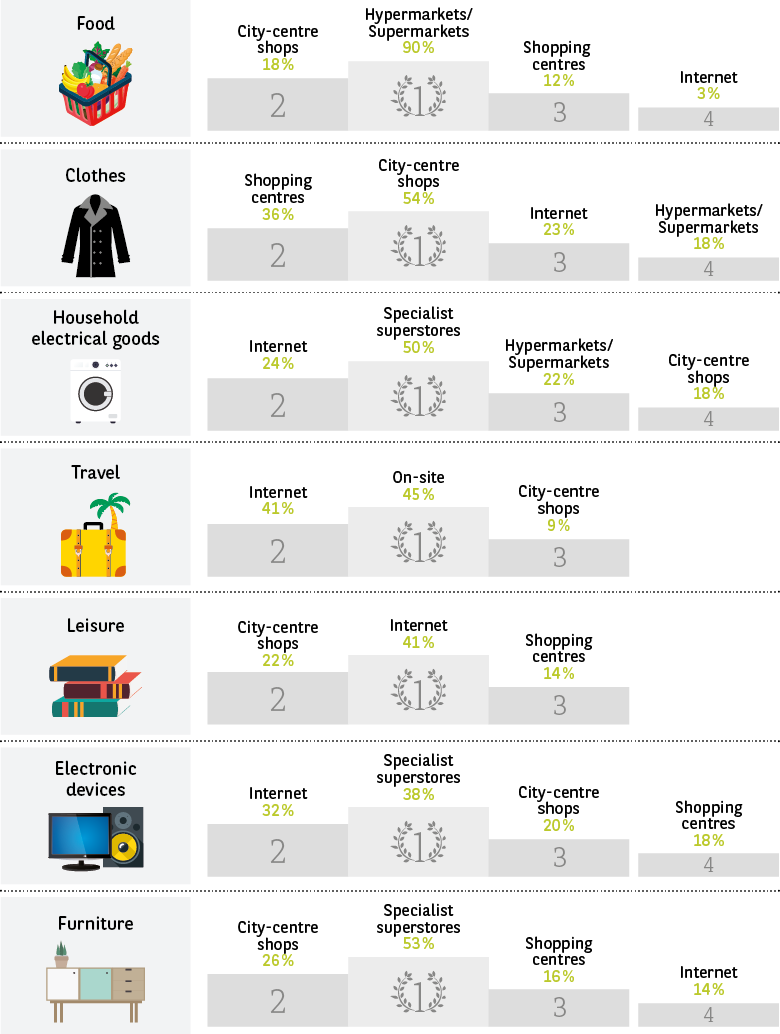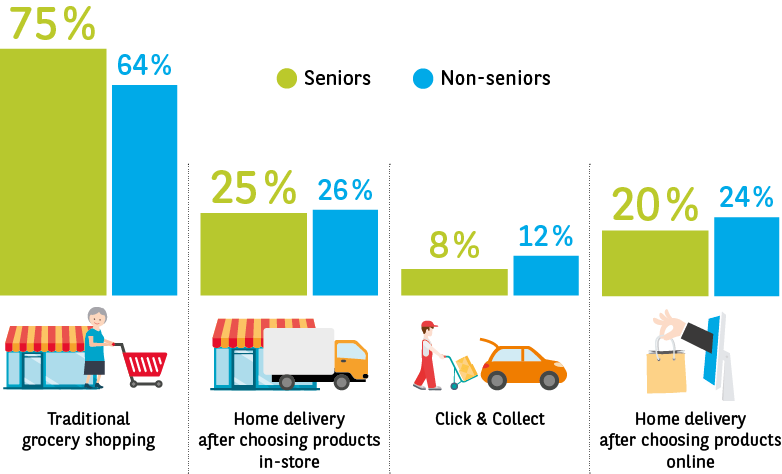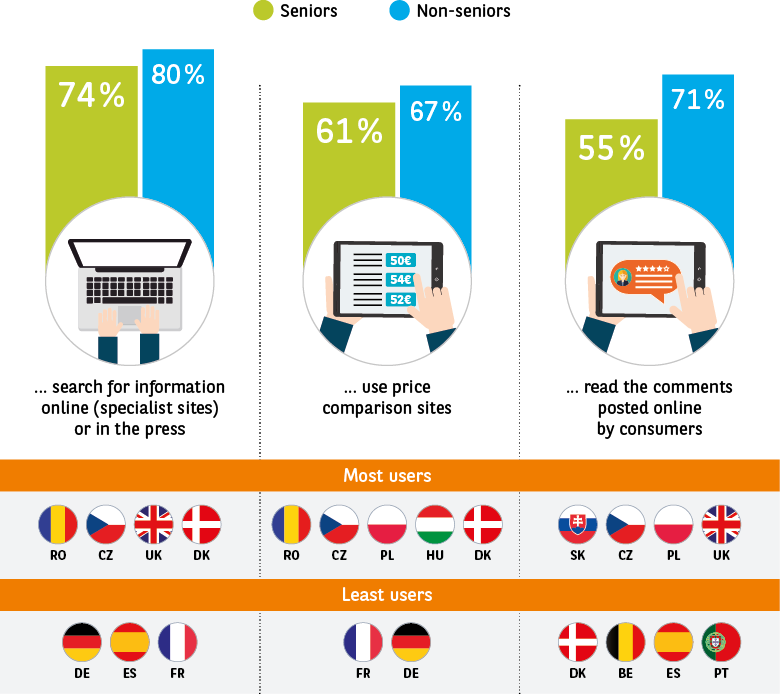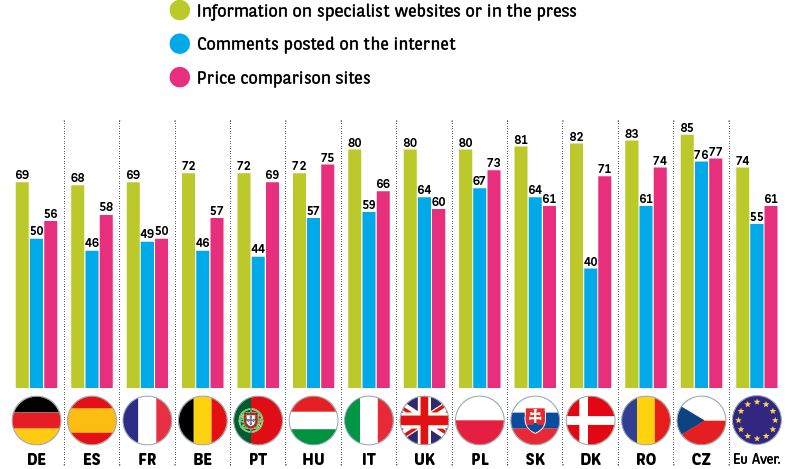CONSUMER SPENDING: A STRONG EMPHASIS ON TRUST


The rise of online shopping
As mentioned above, the fact that seniors surf the web for more than 13 hours a week shows that they have truly turned a digital corner. And this time online is particularly fruitful. Almost two-thirds state that they regularly buy at least one product online. The web is also their primary channel for leisure purchases.
The age factor is negligible. The proportion of 50 to 59 year olds who make online purchases is similar to that of over 60s. However, finances are clearly a factor, with the highest-earning seniors being more inclined to perform online transactions.
Shops lie at the top of the pile
Nonetheless, seniors are still very much attached to shops. They consider them to be an essential retail channel and one that they choose for most products (Fig. 34). Their use far exceeds that of digital channels when it comes to purchasing food, household electrical goods and furniture. 90 % of seniors do most of their food shopping in hypermarkets or supermarkets, compared with just 3 % via the web. Similarly, most seniors buy their furniture in specialist superstores (53 % of cases) or in city-centre stores (26 %), while few are comfortable committing to such purchases online (14 %).
This hesitation is common to all European countries, even though every country has its own specific distribution model. Thus, the French prefer hypermarkets. The Spanish, Portuguese, Italians and Danes, on the other hand, are more more likely to head to local and city-centre shops.
Fig. 34 Where do you usually purchase the following products? TOP 4 answers of seniors.
Source: L’Observatoire Cetelem de la Consommation 2016.
Seeing and touching before buying
Why are seniors slow to embrace online shopping (Fig. 35)? The problem is not mistrust of online payment systems, which is mentioned by only a fifth of respondents, a similar proportion to other generations. The main reason stated is a pugnacious desire to see and touch a product before buying it, so as to gain an idea of its characteristics.
On average, with the exception of travel, 65 % of seniors turn their back on digital channels for this very reason, a much higher proportion than their juniors. And this applies to all products. 80 % do not purchase clothing online for this reason, while the figure for food shopping is 76 %. This is common practice primarily in the Northern countries, such as Germany, Belgium and Denmark.
It is also worth noting that when choosing a product, most European seniors compare the goods themselves at the point of sale.
Before buying durable goods…
83% of seniors / 81% of non-seniors carefully compare the products at the point of sale
Fig. 35 Why don’t you regularly purchase these products via the internet? Select one or more answers.
Source: L’Observatoire Cetelem de la Consommation 2016.
Nothing replaces human contact
With age, seniors become gradually less involved in the professional sphere, making human contact more crucial to them than ever. Making purchases enables them to meet retail staff and other customers, and generally to see people. They are not yet prepared to forego this aspect of shopping.
In addition to closely comparing products, more than 60 % of European seniors seek advice from sales staff at the point of sale before purchasing durable goods, 5 points more than under 50s. The Belgians, Italians and Spanish place the most value on this practice. This attitude is commonest among female consumers, with women aged over 50 stating that they need this advice in two-thirds of cases.
The internet, an anonymous sales channel
This desire to be assisted by an actual person when choosing a product is a significant obstacle to online purchasing. On average, when they decide not to make a purchase via the web, 26 % of European seniors say it is because they need the advice of a sales assistant. This is particularly important to them when buying electronic devices (41 % of seniors avoid doing so online for this reason, compared with 34 % of under 50s). This is not so much the case when it comes to food and leisure activities, whose characteristics they are more familiar with.
Sales assistants are of particular strategic importance in Germany, Belgium and Romania, while the British are not so dependent on their advice.
Before buying durable goods…
61% of seniors / 56% of non-seniors seek the advice of staff at the point of sale
Advice closer to home
Sales assistants are not alone in being able to offer European seniors the advice they need to complete their purchases. The latter are also keen on word of mouth and very sensitive to the opinion of those close to them. Family and friends are a key source of information and their opinions give seniors more confidence. Almost 50 % ask for advice from people they know before buying durable goods.
An advisor (almost) like me
Does the person who advises them need to have a specific profile? At first glance, no. Only 12 % of seniors express a preference for a particular type of profile and they are primarily concerned about the age of the person they wish to speak to during the purchasing process. These respondents tend to prefer the sales advisor to be aged between 30 and 50, highly experienced and able to relate to their aspirations, but they should also be slightly younger than them, with the ability to offer advice on the very latest products and keep them up to date on recent developments.
Shopping, an outing of choice
Unlike 35 to 50 year olds, seniors see shopping as a pleasure rather than a chore. They clearly enjoy going into shops, which should prompt retailers to invest in their quality of service and pamper this enthusiastic market segment. On average, more than 40 % of European seniors state that they do not buy products online because they enjoy going shopping, especially for food and clothes.
Home deliveries hold limited appeal
L’Observatoire Cetelem 2016 also reveals that seniors have less interest in the service offerings created to make life easier for consumers, particularly in food retail. Seniors do not appear to have been fully won over by solutions such as Click & Collect and online grocery shopping with home delivery, which remove physical and social ties that are important to them. Just one in ten seniors are interested in online grocery shopping that requires them to pick up their products from a hypermarket or warehouse (the Click & Collect concept).
And this seems to be a long-term trend. In the future, 75 % of seniors will be shopping for groceries the traditional way, i.e., in stores (compared with 64 % of under 50s) (Fig. 36). In the Czech Republic and Slovakia, seniors seem more prepared to break away from this practice (Fig. 37).
The main alternative for which European seniors may opt is the home delivery of their grocery shopping… once they have selected their products in-store. A way of combining the pleasure of human contact with logistical efficiency. It also makes life easier, since it means not having to carry groceries, as well as being cheaper and greener by expanding the transport options available to shoppers.
Fig. 36 In the future, which of the following options are you likely to choose for your food shopping? Choose a maximum of two answers.
Source: L’Observatoire Cetelem de la Consommation 2016.
Fig. 37 In the future, which of the following options are you likely to choose for your food shopping? Choose a maximum of two answers; scope: seniors.
Source: L’Observatoire Cetelem de la Consommation 2016.
The internet, the home of information
40 % of seniors describe themselves primarily as “utilitarian” web users. This is borne out by the fact that the internet is their primary source of consumer information (Fig. 38). From online comparison tools and user opinions, to consumer websites and detailed product specifications, they seek a whole host of additional information to guide them through their purchases, even if it means going to a store to perform the actual transaction. When purchasing durable goods, more than 80 % use the web to help them make their choice. They visit specialist websites (74 % of European seniors), use price comparison tools (61 %) or read the comments posted by other consumers (55 %). They like comparison tools because they are easy to use and provide them with most of the information they need in a short space of time.
The countries where seniors are most likely to use the web as a source of information are not necessarily the biggest internet users. Information from the web is most useful when seniors are constrained by their purchasing power. In Eastern Europe, more than 70 % of seniors use price comparison sites and more than 60 % read the comments of other users (Fig. 39). Despite stating that they are “hyper-connected”, the French and Germans are the least likely to use price comparison tools.
Fig. 38 Before buying durable goods, you… Very often or quite often.
Source: L’Observatoire Cetelem de la Consommation 2016.
Fig. 39 Before you buy durable goods, quite often or very often you check… As a percentage; respondents: seniors.
Source: L’Observatoire Cetelem de la Consommation 2016.





